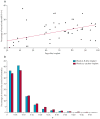High-performance neuroprosthetic control by an individual with tetraplegia
- PMID: 23253623
- PMCID: PMC3641862
- DOI: 10.1016/S0140-6736(12)61816-9
High-performance neuroprosthetic control by an individual with tetraplegia
Abstract
Background: Paralysis or amputation of an arm results in the loss of the ability to orient the hand and grasp, manipulate, and carry objects, functions that are essential for activities of daily living. Brain-machine interfaces could provide a solution to restoring many of these lost functions. We therefore tested whether an individual with tetraplegia could rapidly achieve neurological control of a high-performance prosthetic limb using this type of an interface.
Methods: We implanted two 96-channel intracortical microelectrodes in the motor cortex of a 52-year-old individual with tetraplegia. Brain-machine-interface training was done for 13 weeks with the goal of controlling an anthropomorphic prosthetic limb with seven degrees of freedom (three-dimensional translation, three-dimensional orientation, one-dimensional grasping). The participant's ability to control the prosthetic limb was assessed with clinical measures of upper limb function. This study is registered with ClinicalTrials.gov, NCT01364480.
Findings: The participant was able to move the prosthetic limb freely in the three-dimensional workspace on the second day of training. After 13 weeks, robust seven-dimensional movements were performed routinely. Mean success rate on target-based reaching tasks was 91·6% (SD 4·4) versus median chance level 6·2% (95% CI 2·0-15·3). Improvements were seen in completion time (decreased from a mean of 148 s [SD 60] to 112 s [6]) and path efficiency (increased from 0·30 [0·04] to 0·38 [0·02]). The participant was also able to use the prosthetic limb to do skilful and coordinated reach and grasp movements that resulted in clinically significant gains in tests of upper limb function. No adverse events were reported.
Interpretation: With continued development of neuroprosthetic limbs, individuals with long-term paralysis could recover the natural and intuitive command signals for hand placement, orientation, and reaching, allowing them to perform activities of daily living.
Funding: Defense Advanced Research Projects Agency, National Institutes of Health, Department of Veterans Affairs, and UPMC Rehabilitation Institute.
Copyright © 2013 Elsevier Ltd. All rights reserved.
Conflict of interest statement
MV and AS have a patent application pending that covers some of the methodology used in this study. We declare that we have no other conflicts of interest.
Figures





Comment in
-
Brain-machine interface: closer to therapeutic reality?Lancet. 2013 Feb 16;381(9866):515-7. doi: 10.1016/S0140-6736(12)62164-3. Epub 2012 Dec 17. Lancet. 2013. PMID: 23253622 No abstract available.
-
Neural repair and rehabilitation: Achieving complex control of a neuroprosthetic arm.Nat Rev Neurol. 2013 Feb;9(2):62. doi: 10.1038/nrneurol.2013.1. Epub 2013 Jan 15. Nat Rev Neurol. 2013. PMID: 23318294 No abstract available.
-
Neuroprosthetic control and tetraplegia.Lancet. 2013 Jun 1;381(9881):1900. doi: 10.1016/S0140-6736(13)61153-8. Lancet. 2013. PMID: 23725722 No abstract available.
-
Neuroprosthetic control and tetraplegia--authors' reply.Lancet. 2013 Jun 1;381(9881):1900-1. doi: 10.1016/S0140-6736(13)61154-X. Lancet. 2013. PMID: 23725723 No abstract available.
References
-
- Soechting JF, Ross B. Psychophysical determination of coordinate representation of human arm orientation. Neuroscience. 1984;13:595–604. - PubMed
-
- Desmurget M, Prablanc C, Rossetti Y, et al. Postural and synergic control for three-dimensional movements of reaching and grasping. J Neurophysiol. 1995;74:905–10. - PubMed
-
- Moran DW, Schwartz AB. Motor cortical representation of speed and direction during reaching. J Neurophysiol. 1999;82:2676–92. - PubMed
-
- Velliste M, Perel S, Spalding MC, Whitford AS, Schwartz AB. Cortical control of a prosthetic arm for self-feeding. Nature. 2008;453:1098–101. - PubMed

